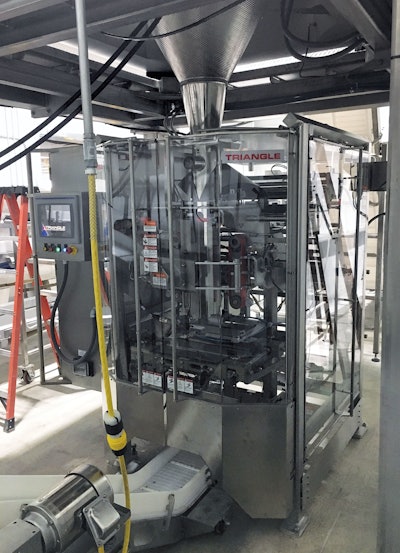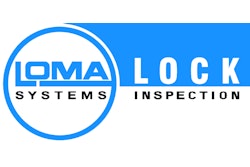For more than 30 years, Torbert Produce Inc. has grown farm-fresh vegetables in the Southeast U.S., namely Florida City, FL, and Ty Ty, GA, under the Torbert Produce and 5 Brothers Produce brands as well as under private labels. The company’s produce, primarily sold into retail, includes green beans, zucchini, summer squash, eggplants, bell peppers, and a variety of beans.
One of its larger clients, a major Southeast grocery chain, had long accepted 1-bushel boxes of fresh, unsnipped (stem-on) green beans at its distribution centers to be packaged under the store brand. There, the retailer would package them in 1-lb plastic film bags on a vertical bagger. But in late 2018, the retailer made some internal changes that resulted in a shift away from the store brand. As a result, Torbert was asked to start doing its own bagging, and doing so under its own 5 Brothers label.
For Charlie Porter, Director of Operations, Torbert Produce, vf/f/s was an all-new challenge. He quickly began researching bagging machines and scales to determine what would be the best fit for what they were looking to do.
Several combination scale and vf/f/s solutions were considered early on, but Porter selected Triangle Package Machinery Co. Coincidentally, the retailer uses three Triangle baggers, one in each of its distribution centers, and had used a similar system when it had been bagging the unsnipped beans in-house.
After talking with David Hart, Southeast Regional Sales Manager at Triangle, “and going over all we wanted, or thought we wanted,” Porter chose a system that included an XM15 intermittent motion vf/f/s bagger from Triangle, an Ishida combination scale, and a Videojet thermal transfer printer.
Several factors went into the decision-making process, but Porter admits that most of it was predicated on the success the retailer had in running un-snipped green beans on a similar system. He had quickly been introduced to the fact that the unsnipped beans present a difficult application, so he was naturally receptive to the pre-existing solution.
“We find that these unsnipped green beans are harder to bag compared to a snipped version, so we had to get a scale and bagging system that would be more compatible with the extra challenge they present,” Porter says. “That little curved stem makes a big difference in how they enter the bag and how they pass through the scale. The model of the combination scale we selected was a little larger than what we had originally planned on using. The larger bucket eliminated some of the jamming problems that the hooked stem could create.”
Triangle’s Model XM15 is designed to run pillow, gusseted, and flat-bottom bags from 3.5 to 15 in. wide, at speeds up to 120 bags/min, with the speed dependent on bag size and style. For Torbert, the new system runs 1-lb pillow bags of green beans faster than 50 bags/min.
This vf/f/s machine features intermittent-motion film advancement by Rockwell Automation, servo-driven vacuum belts and Rockwell Automation servo-actuated X-axis jaw motion, as well as food-grade, epoxy-painted, washdown-rated motors. Torbert opted for a stainless steel wet-washdown machine finish with fully-welded tube frame construction, which is designed to meet the requirements of wet or frozen products and hose down sanitation. It uses IP67 rated motors and components with dry air purging for harsh sanitation requirements. The bagging machine is available in a range of finishes for different environments, including a painted white frame for dry environments, stainless-steel for wet and IQF applications, or can be designed to meet 3-A and USDA sanitation standards for applications requiring stricter sanitation requirements.
Triangle and Heat & Control frequently partner for weighing solutions in produce and other industries. To accurately weigh the green beans before depositing into the bagger, the system includes Heat & Control’s Ishida Computer Combination Weigher, Model RV-214W-1S/70-WP-H. Designed for high-speed operation with accuracy and reliability, Porter says the weigher reduces the need for operator involvement, minimizes sanitation costs, and provides for user-friendly operation and seamless integration into an Ethernet network. A set of 14 radial feeder pans vibrate to move product to each of the pool hoppers, while high-speed radial feeder drives with carbon fiber flexures move product.
Upstream and downstream equipment
Rinsed, unsnipped green beans enter the building in bins large enough to hold 504 lb of the produce. A hydraulic dump tips the bins to empty their contents onto to an initial belt conveyor, which then makes a 90-deg turn transferring produce to a second conveyor, this time an incline conveyor. On a mezzanine level, a shaker table levels the beans into a single, uniform layer that’s one-bean deep, then the beans are dropped to a floor-level grading table. Operators perform a final visual inspection for imperfections as the beans pass by, finally onto another incline conveyor that feeds the Ishida combination scale. Agri Machinery and Parts (AMP) provided and integrated all of the material handling equipment upstream from the scale and downstream from the bagger.
Portioned beans then enter the Triangle intermittent bagger, where they are pouched in printed, perforated rollstock designed for fresh produce. Bags exit the vf/f/s at the bottom of the machine, where they are immediately incline conveyed to waist level, then transferred 90-deg to a belt conveyor, also from AMP.
A metal detection system from Loma inspects each bag, and a Videojet Thermal-Transfer (TT) printer then adds a packed-on date onto each bag, before they are conveyed to case-packing stations. Hand-erected corrugated cases that have been ink-jet coded with a lot number are hand-packed with 18 bags to a case, closed without seal, hand-palletized 49 cases to a pallet, and stretch wrapped before heading into a cooler to await distribution to retailers.
Service and support
Beyond the technical merits of the system, Porter was seeking a firm understanding of what level of service he would receive after the purchase. Getting the machine up and running was a learning curve for Porter since this is the first bagging machine the company has had. He leaned heavily on Triangle’s service technicians.
“Having tech support, having good service, and getting parts fast were a big part of the [purchase] decision,” he says. “Triangle’s service department and local technicians were only a phone call away for questions and tech support. This was priceless, as it could be business hours, weekends, or nights. They were always willing to help. [Our tech] was great with setting up the machine and teaching us how to use and maintain the machine.”
As a neophyte to bagging who had to quickly remove the training wheels and start producing, Porter has this advice to others in his situation: “Unless you know exactly what you want, go over what you think you want or need with the sales person,” Porter advises. “Make sure you understand what it is you want to do, what you need to do, and what you can do in the future with the machine if your business changes or items change.
“The results have been great,” he adds. “We are packing what we need and more when needed. After six months of operation I would buy another one just like what we have.”
Pouches lead flexible packaging charge
The broad use of plastic pouches in global food, beverage,home and personal care, and industrial applications is pushing this segment to grow at the fastest rate among flexible packaging types.
The flexible packaging market is segmented into aluminum, pouch (either stand-up or lie-flat), blister and strip packs, plastics, and paper. This market is segmented by material used as well as application, and according to a new report from PMMI: 2019 Flexible Packaging Assessment Report, the plastic pouch segment is expected to grow 20% by 2022, followed closely by stand-up pouches at 19%.
The most common format of the flexible packaging market, the plastic pouch’s ability to enable co-polymerization, and the addition of plasticizers, blowing agents, antibacterial additives, and color-changing additives, are also speeding growth of this segment.
Pillow pouch and stand-up pouches are flexible, easy to carry, and light weight, and advances in pouch characteristics (e.g., resealable closures, spouts, and tear notches) and pouch manufacturing technology (e.g., machinery with increased line speeds) will continue to lower production costs, making pouches more competitive with other forms of packaging, like cartons and cans.
Pillow Pouch Growth
• Versatility in design that can easily accommodate liquid, solid, and powder products.
• Rising dairy consumption (e.g., milk, curd, yogurt, and cream products) as well as processed food and beverage industry.
• Rising shipments of packaged food products, particularly from developing markets in the Asia/Pacific region.
Stand-up Pouch Growth
• Expanding consumption of food & beverage, dairy, and cosmetics products.
• Rising consumption of over-the-counter products in the healthcare industry.
Download the entire report, or a free executive summary, at pwgo.to/4077.
Source: PMMI Business Intelligence, 2019 Flexible Packaging Assessment Report. —Kim Overstreet
































